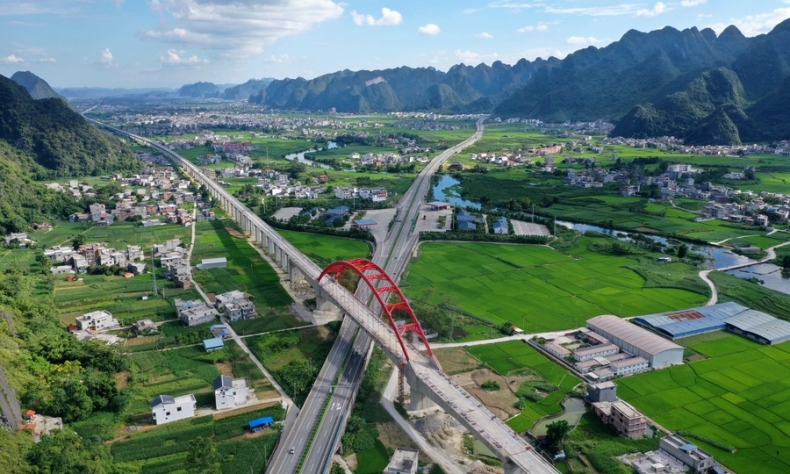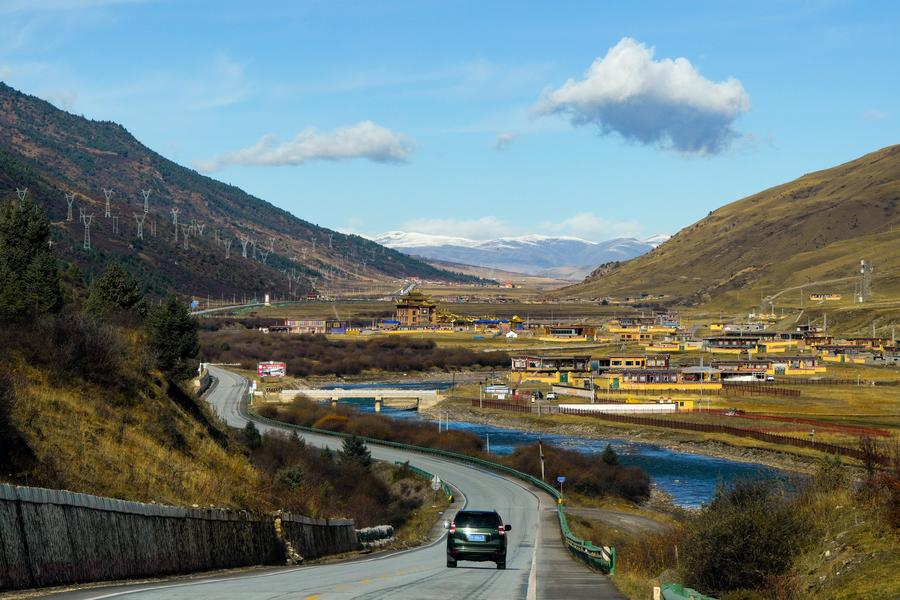A Deep Dive into the Development of China’s Rural Road Network

China’s rural road construction has played a major role in promoting poverty alleviation and achieving shared development.
Due to the extremely challenging terrain it had to traverse, it took over one year to construct the less-than-4-km road connecting Abuluoha Village to Tuojue Town in Butuo County, Liangshan Yi Autonomous Prefecture of Sichuan Province in southwest China. The road is surrounded on three sides by towering mountains and overlooks a river on the other.
Abuluoha, which means “a place off the beaten path” in the Yi ethnic group’s language, has long remained isolated, cut off from the outside world by the surrounding peaks. To overcome these natural barriers, three tunnels and a steel bridge were built along this short stretch of road, finally linking the remote village to broader regional infrastructure.
Roads to opportunities
The road has reduced the travel time from the village to the nearest town from over three hours on foot to only a few minutes by car. “Before the road was built, leaving the village was a daunting task,” villager Benzi Rige told newspaper Sichuan Daily. Residents had two options: a perilous climb up steep mountain slopes, which inclines nearing 90 degrees; or a treacherous descent down a narrow path leading to the valley in the upper reaches of the Yangtze River, followed by a risky zip-line crossing over the turbulent waters.
Secluded by its challenging geography, Abuluoha had suffered persistent poverty. The road’s construction, which began in 2019 and was completed in 2020, marked a milestone for the village. This development has since opened up new economic avenues for the villagers, who had previously relied solely on corn cultivation.
Shortly after the road’s completion, the village began experimenting with navel orange farming. Jilie Ziri, Secretary of the village branch of the Communist Party of China, told China Central Television (CCTV) in an interview aired on December 9, “In 2020, we harvested 1,500 kg of navel oranges from about 24.3 hectares of land, earning 30,000 yuan ($4,000).” Supported by national development funds, the project has since expanded into its second phase, now covering approximately 125.5 hectares.
The village has also diversified its agricultural activities, now cultivating specialty crops like mangoes and Sichuan peppercorns while also establishing a new livestock base for black goats and cattle. Improved access to the area has also boosted tourism, with new guesthouses, parking facilities and other amenities attracting over 10,000 visitors last year.
The transformation in Abuluoha reflects a broader national effort to enhance rural infrastructure. According to the China’s Rural Roads in the New Era white paper released by the State Council Information Office in November, by the end of 2023, China’s rural road network spanned 4.6 million km, accounting for 84.6 percent of the country’s total road range.
“Over the past decade, China has either constructed or renovated more than 2.5 million km of roads, connecting all suitable townships and villages with paved roads and forming a comprehensive rural transportation network,” Wang Tao, an expert from the Ministry of Transport, told CCTV. This network has boosted the local economy by enhancing access and supporting industries like tourism and agriculture.

In areas like Haiyuan County in Ningxia Hui Autonomous Region, villages have leveraged these roads to develop industries such as goji berry cultivation, creating a complete industry chain from farming to processing. Similarly, in Yumai Township of Shannan City, Xizang Autonomous Region, a new 50-km road completed in 2019 has transformed the area with stunning landscape into a popular destination for self-driving tours.
Development and maintenance
“Understanding that both construction and maintenance are essential for road development, China engages in the scientific and comprehensive maintenance of rural roads,” the white paper stated. “By improving road conditions, ensuring transport safety and carrying out roadside greening and beautification programs, the country has seen a steady improvement in the maintenance efficiency of its rural roads, as well as an increase in their service capacity.”
To further reform its rural road management systems, China has implemented an innovative “road chief” system.
Launched in 2020, the system appoints a principal road chief, usually the top county-level leader, as well as road chiefs at the county, township and village levels. They are responsible for overseeing rural road construction, improving transportation services, and addressing road hazards.
As of late 2023, 680,000 road chiefs had been appointed across the different levels. Li Wenxuan, a road chief in Jiyuan City, Henan Province, oversees a 19-km road connecting the Taihang Mountains to the Yellow River. “As a road chief, I work closely with departments from natural resources, forestry, culture, tourism, and others to discuss the construction and management of this road,” Li told CCTV.
In 2021, Jiyuan launched high-standard road improvements, which spurred the development of local industries such as agriculture and tourism. As a result, the average local per-capita income rose from 28,000 yuan ($4,400) four years ago to 37,000 yuan ($5,800).
The white paper also emphasized the growing professionalism in rural road maintenance. For instance, Louxing District in Loudi City, Hunan Province, manages over 1,200 km of rural roads using AI-powered smart inspection devices. These devices can detect cracks in the road surface with millimeter-level precision, achieving an accuracy rate of over 90 percent. Additionally, a damage database has been established, allowing for precise management through algorithms.

Local governments are actively exploring innovative financing mechanisms for the construction and maintenance of rural roads, which have helped alleviate funding shortages to some extent.
Lishui City in Zhejiang Province has pioneered disaster insurance mechanisms for rural roads in mountainous areas. In 2020, Lishui became the first city in the province to complete a unified tender for comprehensive insurance covering rural road infrastructure, aiming to strengthen financial protection against risks.
Guo Jinfan, head of the rural road management station in Zhaitan Township in Lishui, has seen the benefits of this insurance firsthand. “Repairs for minor damage caused by disasters used to take more than 10 days, but now they can be completed in just two or three days,” he told newspaper Lishui Daily. “The recovery time from major landslides has been reduced from three to six months to within one month,” he added, highlighting the increased efficiency brought by the insurance.
Global role
Drawing on its extensive experience in constructing and managing rural roads, China has developed world-class technical standards and specifications for road engineering. These standards are highly practical and adaptable, shaped by a wide range of projects across China’s vast and geologically diverse terrain, according to the white paper.
China has also shared its expertise internationally, providing aid and support for numerous rural road infrastructure projects in other developing countries. In 2022, China established the Global Sustainable Transport Innovation and Knowledge Center, a platform that promotes cooperation and knowledge exchange, sharing China’s valuable experience in rural road development with the global community.
One notable example is the road construction project on the outskirts of Antananarivo, capital of Madagascar, which was funded through free aid from China. This project has greatly improved the transportation of eggs from the town of Mahazaza, helping to boost the local poultry industry. Locally, this road has affectionately come to be known as the “egg road.”
“China’s rural road construction has played a major role in promoting poverty alleviation and achieving shared development,” Wang Gang, Deputy Minister of Transport, said at the Global Sustainable Transport Forum held in Beijing in September. “China will continue to strengthen practical cooperation with other nations through experience sharing and technical exchanges, with the goal of establishing a more inclusive, fair and sustainable rural transport system globally.”
 Facebook
Facebook
 Twitter
Twitter
 Linkedin
Linkedin
 Google +
Google +










